Copan › Copper in Antiquity › The Gold Crowns of Silla » Origins and History
Articles and Definitions › Contents
- Copan › Origins
- Copper in Antiquity › Origins
- The Gold Crowns of Silla › Origins
Ancient civilizations › Historical places, and their characters
Copan › Origins
Definition and Origins
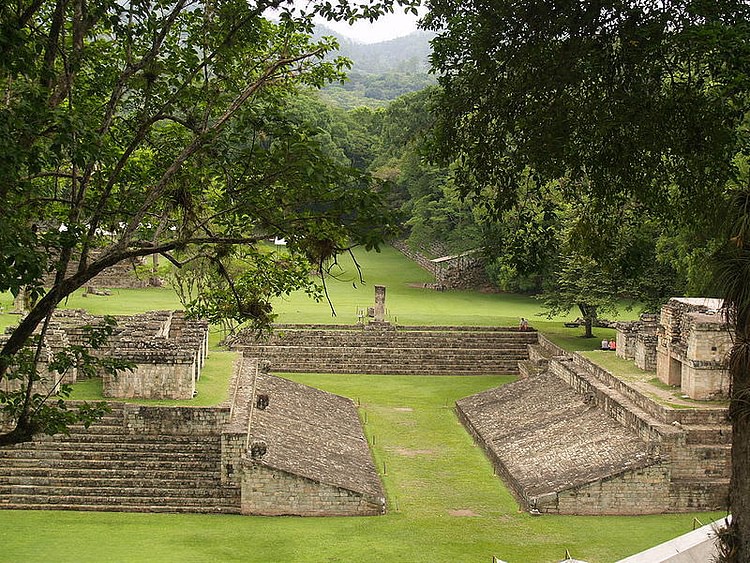
Copán (in modern Honduras) is located on the floodplain of the river of the same name. It was the most southerly of the Classic Maya centres and, at an altitude of 600 metres, the highest. Copán reached the height of its power in the 8th century CE when it boasted 20,000 inhabitants. An artificial platform, built to a height of over 30 metres, forms a main 12 acre acropolis with lesser platforms spreading out to form an imposing mass of precincts of monumental courts and pyramids. An elite residential area and more modest dwellings surrounded the sacred centre so that Copán once covered some 250 acres.
HISTORICAL OVERVIEW
A farming settlement from as early as 1000 BCE, Copán emerged as a major centre in the Early Classic Period (250-550 CE), almost certainly with influence from Teotihuacan. The Copán rulers themselves claimed their own dynasty was founded in 331 CE, but there is no record of the names of these early rulers. The traditional named founder of Copán was actually K'inich Yax K'uk Mo' ('Great Sun Quetzal-Macaw'), who reigned from 426 CE to c. 437 CE and who was probably not himself from Copán but another Maya city, perhaps Tikal. K'inich Yax K'uk Mo' was the first of a line of 16 rulers, and he is credited with making Copán a major centre, whose wealth was based on regional conquest and control of the lucrative local trade in obsidian and jade.
THE TRADITIONAL FOUNDER OF MAYA COPÁN WAS K'INICH YAX K'UK MO'.
King Smoke Imix (the 12th ruler, reign 628 - 695 CE) was another Copán ruler who oversaw a period of great prosperity in the 7th century CE. The ruler known as King 18 Rabbit or Waxaklahun Ubah K'awiil (reign 695 - 738 CE) again aggrandized Copán in the early 8th century CE. The last well-documented ruler was Yax Pasaj Chan Yopaat, whose mother was from Palenque and whose reign ended in 820 CE. Although Copán subsequently declined, there are no great signs of destruction, and there is some evidence (albeit controversial) that the elite rulers of Copán survived the general Maya collapse, which occurred between c. 760 and c. 910 CE, and continued their rule until 1000 CE.
Copán competed with local rival Quirigua over the centuries. Although Copán founded Quirigua, King 18 Rabbit was famously captured and beheaded by Chan Yopaat of Quirigua in 738 CE, possibly whilst campaigning for sacrificial victims. Copán recovered from this blow and even expanded the acropolis, but in the longer-term Quirigua gained in prominence, and Copán would never again enjoy the power and prosperity enjoyed during the Yax K'uk Mo' dynasties.

Copan Site Plan
ARCHITECTURE
The unusually few buildings at Copán, constructed using local tufa, andesite, and limestone blocks cemented with mud and faced with stucco, include several pyramid structures, a ball court, and the Hieroglyphic Stairway, all laid out along a north-south axis. Many of the structures were deliberately placed to take advantage of specific views of the surrounding valleys, notably the ball court with its stone macaw markers. The river Copán has washed away a sizeable chunk of the east side of the main site, especially the grand stairway, but enough remains of the site to indicate its once great prosperity.
The Hieroglyphic Stairway is a wide series of 63 steps which give access to the main court and heart of ceremonial Copán which dates to the 6th century CE. The stairway was constructed in the first half of the 8th century CE and is rich in both relief and fully round sculpture, a feature of Copán. Its name derives from the 2,500 glyphs which adorn it. These narrate the history of the Late Classical dynasty, and it constitutes one of the longest surviving Maya texts. The steps are interrupted by five Copán rulers and captives, whilst at the top of the stairway there was the shrine to Yax K'uk Mo'.
The 8th century CE kings of Copán built elaborately stucco-decorated tombs which were then deliberately covered in their entirety by less ornate pyramids, sometimes several times. An example is the largest building and earliest funerary monument Structure 16, a nine level pyramid inside of which are two tomb buildings known as Rosalila and Margarita. Temple 16 was further excavated in 1996-7 CE, and within was discovered the earliest structure in the pyramid, a small platform temple in the Teotihuacan style, inside of which was a tomb of a male over 50 years of age. As it is now known that Temple 16 was dedicated to the cult of Yax K'uk' Mo', the remains are considered to be of the great ruler himself. Isotopic analysis of the teeth suggests the man came from near Tikal. The neighbouring tomb of Margarita, the richest at Copán, is now considered to be that of the widow of Yax K'uk' Mo'.
Another important building at Copán is the rectangular Temple 22 with its short stepped entrance. It has mask facades on all four sides and dates to before 780 CE. The doorway is framed by a giant serpent-mask so that the portal seems to be the creature's open mouth with fangs on the sill and sides. This is a common Maya technique to reproduce the entrances to sacred caves and may specifically represent the sacred mountain entrance to the Maya underworld Xibalba of Maya mythology. The cornices were additionally decorated with maize gods. Another important building is Structure 22a which was built as a popol na or council house, where nobles advised the king and which has a fish on its façade, possibly the symbol of a prominent noble family.
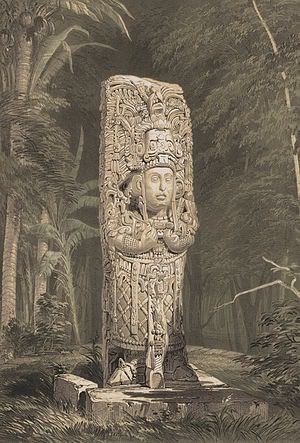
Stela D at Copan by Catherwood
ART & POTTERY
Copán art is well represented by 14 altars, some which commemorate units of the Maya calendar, and over 60 elaborately carved stelae depicting Copán rulers (especially King 18 Rabbit). Several of the later stelae stand above a small cruciform vault which contained votive offerings, and some stelae were placed to create lines of sight connected to solar dates important in the agricultural year. Other fine examples of three-dimensional sculpture by Copán artists include a half-metre high monkey scribe god and a stone bust of the young maize god from Temple 22.
From c. 800 CE Copán also produced its own distinctive pottery style which was exported and even imitated, notably in western El Salvador. The style, known as Copador pottery, is distinct for its shiny surface (from the presence of hematite in the pigments) and stylised human and bird figures. Other finds include the 'Dazzler', a three-legged lidded box which depicts a Copán ruler and temple. The vessel is brightly coloured, and its clay came from distant Central Mexico. Altar Q has relief figures of 16 Copán rulers, including Yax K'uk Mo' (wearing the goggles of a Teotihuacan war god) handing over the sceptre of power to Yax Pasaj Chan Yopaat who commissioned the altar in 776 CE. Finally, there are various objects related to the Mesoamerican ballgame indicating an influence from Veracruz.
Copper in Antiquity › Origins
Definition and Origins
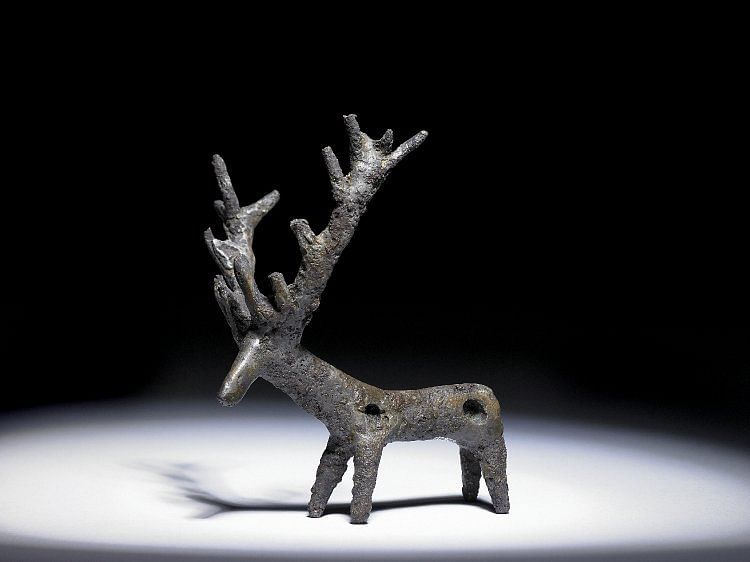
Copper was probably the first metal used by ancient cultures, and the oldest artefacts made with it date to the Neolithic period. The shiny red-brown metal was used for jewellery, tools, sculpture, bells, vessels, lamps, amulets, and death masks, amongst other things. So important was the metal in human development that it gave its name to the Copper Age, today better known as the Chalcolithic. Copper was necessary to make brass and, of course, bronze, the metal which gave its name to the time period succeeding the Copper Age, besides many other alloys. From Phoenicia to Mesoamerica, copper was a badge of elite status before becoming more widely available. A handy form of exchange in the trade between cultures, eventually, copper symbolic goods were replaced by more manageable ingots which, in turn, evolved into even more convenient coins.Gold and silver may have been common enough for the rich and powerful, but if there was one pure metal that ordinary people in the ancient world could get their hands on, it was copper.
AVAILABILITY & MINING
Copper was easily found in its metallic state in many areas of the ancient world, albeit in relatively small quantities. The shiny red, orange or brown metal was first used in the Balkans, Middle East, and Near East from 8000 to 3000 BCE. Egypt and Europe later followed suit and began to make their own copper artefacts. Soft and malleable, it was an ideal material to manufacture decorative luxury goods.
THE LEGENDARY COPPER MINES OF KING SOLOMON HELPED BUILD THE FORTUNES OF ISRAEL.
When metalworkers realised it could be smelted using charcoal furnaces, the exploitation of copper-rich ores became more widespread from the 2nd millennium BCE. Such ores were present in significant quantities at sites across the ancient Mediterranean: Cyprus (whose very name may derive from the metal), Attica, the Cyclades (especially Kythnos), and the Levant, in particular. The legendary copper mines of King Solomon helped build the fortunes of Israel, even if they may well have belonged to the Edomites. Other, less important copper deposits, were exploited in England, Wales, France, Italy(especially Elba, Sardinia, and parts of Etruria ), Spain, and Mauritania.
On the other side of the world, Mesoamerican cultures (c. 650-1200 CE) were provided with plentiful amounts of copper from open-pit mines in western Guerrero and Oaxaca on the west coast of Mexico and Veracruz on the east coast. Japan was a rich source of the metal and, from around 1000 CE, exported significant quantities to neighbouring China who, converting it into coinage, sent tons back again so the Japanese could use it as their own currency. Similarly, Korea was rich in copper, and the Goryeo kingdom, in particular, exported it to China, although they minted their own copper coins. China did have its own copper mines along the south banks of the Yangtze River, but these may not have met the country's huge needs.
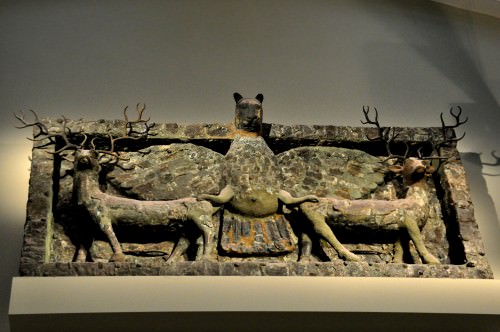
Imdugud Copper Frieze from the Ninhursag Temple
The earliest known smelting site is in Serbia and dates to c. 5000 BCE. Early furnaces could only create a copper-rich slag which had to be further treated in a clay crucible, but with the development of charcoal-burning furnaces and the use of bellows, 1200 degrees Celsius could be reached, and a much more refined product thus became achievable. Copper melts at 1084 degrees Celsius, and so it could be reduced to a molten state of pure copper where it collected at the base of the furnace. Ingots were made by pouring the metal into stone or clay moulds. With more technological developments, notably by the Romans, the more difficult ores of copper sulphide could be exploited. Indeed, the Romans became so adept at extracting copper on a large scale that one of their mining operations in Jordan still leaves intolerably high traces of copper in the animals and wheat of the area.
USES
Copper, with its shiny red-orange lustre when polished, was used by many ancient cultures as a material for jewellery manufacture and art objects such as small figurines. The metal was also used for remarkably similar tools across cultures from the Etruscans in Italy to the Moche civilization of South America, especially axes, adzes, chisels, awls, tweezers, and needles. Burnished copper was a popular choice of material for tableware and serving dishes amongst societal elites. The metal was used to make parts of musical instruments, surgical instruments, and as a decorative inlay material too. Copper prestige goods in Europe more specifically indicated elite rank and took the form of crowns, mace-heads, and standards.
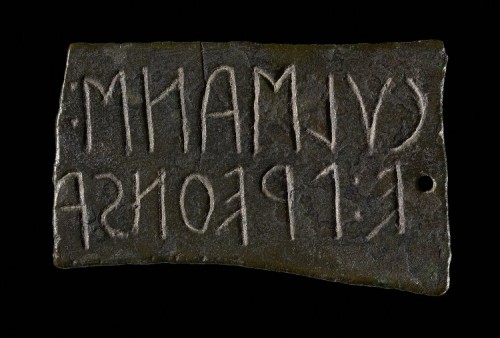
Etruscan Inscription Plaque
A famous hoard of copper prestige goods comes from the Nahal Mishmar cave in Israel where more than 200 such items were carefully wrapped in reed mats and buried in the Chalcolithic period, perhaps in the 5th millennium BCE. The colour Egyptian Blue which Minoan fresco painters were so fond of using was made from copper compounds. Copper could also add red, green, and blue to ancient glass. The Carthaginians made symbolic copper razors to bury with their dead. Beaten into thin sheets copper was a useful writing surface, perhaps most famously seen in the three copper scrolls found in the Qumran caves, Israel, where the Dead Sea Scrolls were also discovered.
In ancient Mesoamerica, bells may have served the function of showing a person's elite rank, even if the majority have been found in a burial context. The Aztecs were keen on copper and compelled tribute from conquered tribes, which often took the form of copper axes. Too thin to have any functional use, these axes may have acted as a primitive currency. In ancient South America building blocks at the site of Tiahuanaco ( Tiwanaku ) near Lake Titicaca used copper clamps to keep them in place.The Incas, meanwhile, used copper for an altogether more practical purpose, sheathing their war clubs with vicious copper spikes. Inca warriors wore metal plates, probably as symbols of rank rather than proper armour, and the lowest of these were made of copper, the highest being of gold.
Copper was made even more useful by mixing it with other materials to make an alloy of superior strength and so better able to resist corrosion. Bronze was thus made by joining copper with arsenic, antimony, or tin while brass, an easier material to cast, consisted of copper and zinc. Adding lead to copper also made a better casting material. The Romans similarly used copper to produce more useful alloys. Copper and bronze were in many instances eventually replaced by iron which was more readily available and filled the gap left by shortages of tin. The Mesoamericans were equally adept at producing alloys, notably copper-silver, copper-gold, copper-arsenic, and copper-tin. Further south, in ancient Colombia, the alloy of gold and copper, known as tumbaga, was especially popular with metalsmiths.
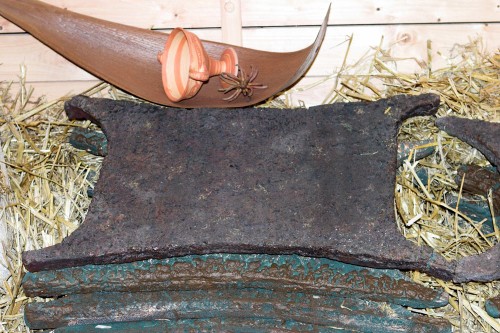
Copper
EXCHANGE & CURRENCY
As a useful and prized material, copper became a commodity for exchange in the form of flat ingots. Copper ingots have been found at many Bronze Age sites such as Hagia Triada (600 kg beneath the palace building) and Zakros on Crete, and in the Uluburun shipwreck, which, dating to 1330-1300 BCE, was carrying 348 weighing in at around 10 tons. Many of these ingots have the small handle at each corner which is familiar to many others of the Bronze Age Aegean. A mould for such ingots, sometimes called “oxhide”, was discovered at Ras ibn Hani, the port of ancient Ugarit in Syria. Other common shapes of ancient copper ingots are circular buns, rings, perforated axes, and daggers.
Chemical analysis on copper ingots in Greece and Sardinia show that local copper was used to manufacture goods, while copper from Cyprus remained as stored ingots suggesting that there were two levels of use: one for practical use and another as a storage commodity or as an exchange gift between elites. Indeed, it was probably the demand for metals which first created the early Mediterranean trade links between cultures. Such documents as the Amarna letters show that copper (probably from Cyprus) was traded between Egypt and Assyria, Babylon, and the Hittite Empire in the 14th century BCE.Not only valued as a material, then, copper was also used as a currency.

Roman Copper As
The Phoenicians shipped copper around the Mediterranean and certain hotspots of metallurgy sprang up where it was worked, stored and passed on. One such centre was Bahrain which passed on copper from Mesopotamia to the Harappan culture of the Indus Valley in India and Pakistan. Western Mexico of the Epiclassic and Postclassic periods became a noted centre for the production of copper bells which were traded across central America. The Lambayeque civilization of northern Peru, like the Aztecs, also produced copper axes to be used as a form of currency and ingots shaped like a capital I which have been found carefully piled in buildings at Batan Grande.
Copper was used in coinage by the Greeks, Romans, and Chinese, amongst others. Silver largely took over the role as the metal of choice for coins, but copper remained in place for low values such as the Roman as and nummus and was always handy to mix in with gold and silver to make higher value coins when the government purse strings had to be tightened a little.
The Gold Crowns of Silla › Origins
Ancient Civilizations
The Silla Kingdom ruled south-eastern Korea during the Three Kingdoms period (1st century BCE - 7th century CE) and then, as the Unified Silla Kingdom, all of Korea from 668 to 935 CE. The Silla produced fine pieces of art, but their most celebrated works are undoubtedly the five gold crowns which have been excavated from five royal tombs. These magnificent crowns, and many more fine jewellery pieces too, fully justify the ancient capital's name of Kumsong or ' city of gold.'
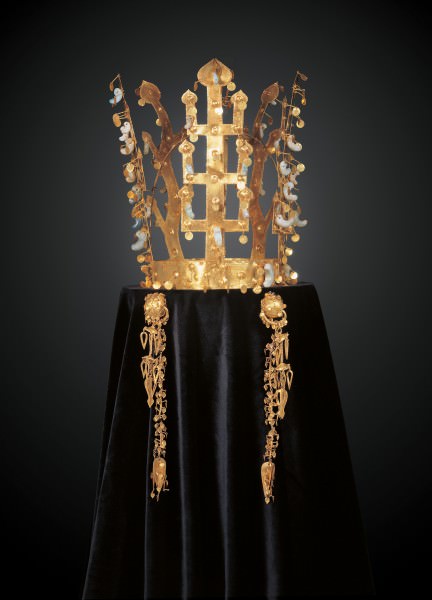
Silla Gold Crown
SAVED FOR POSTERITY
The Silla kings and queens were buried at Kumsong (modern Gyeongju /Kyongju) in large earth mounds containing stone-lined tombs. The contents of these tombs were protected from the elements by the technique of applying clay between layers of stones under the earth mound. Even more importantly, though, the riches within were saved for posterity by the Silla architects' decision not to construct horizontal entrances to their tombs as was the case in the other kingdoms of the period.Consequently, the tombs were not looted in antiquity and the riches of Golden Silla were saved for future generations.
The first crown was rediscovered by chance in 1921 CE when a policeman noticed children digging for glass beads in a pile of earth near a construction site in southern Gyeongju. On closer inspection, he saw pieces of gold in the ground and it soon became evident that the site was once a burial mound, which had flattened over the centuries. Excavations began and soon discovered the glittering treasures buried with an occupant now vanished to decay. The tomb was dated to the second half of the 5th century CE and became known as the Gold Crown Tomb. The body inside had been placed in a wooden box wearing a gold crown, girdle, earrings, and rings on the toes. Around the coffin were many other precious objects – lacquer goods, mirrors, ornate stirrups, horse-fittings, weapons, armour, bronze vessels, and ceramics. Four more tombs were then discovered nearby and excavated over the following decades. These are the Great Tomb at Hwangnam, Cheonmachong (the 'Heavenly Horse Tomb'), the Gold Bell Tomb, and the Auspicious Phoenix Tomb.

Gold Silla Crown
CROWNS: DESIGN & MANUFACTURE
Scholars note some points of similarity, and therefore possible influence on the Silla crown designs, to gold crowns found in the Black Sea area, Bactria, and China. The other two kingdoms of the Three Kingdoms Period ( Baekje and Goguryeo ) also made crowns, in the latter case using gilt-bronze. The Silla gold crowns generally have three parts probably worn all together: an openwork tall conical cap, a piece in the form of a wing or butterfly which fitted into the cap, and a diadem.
The diadems are fitted with tall upright antlers (at the sides) and tree-like formations with U-shaped branches (at the front), which indicate a link with Scytho-Siberian shamanism. Hanging from the side of the crown are chains with pendants. The diadems are around 30 to 45 cm (17 inches) tall. Made of thin pieces of cut sheet-gold they are embellished with granulation, punched dots, rivetting, filigree, suspended disks or spangles, and pendants of twisted gold wire decorated with crescent-shaped pendants of jade ( gogok in Korean or magatama in Japanese). The latter are similar to those found in Japanese tombs belonging to the Kofun period (4th-6th century CE) and symbolise new life. The gold crown from the Auspicious Phoenix Tomb is topped with a phoenix (or perhaps the three-legged crow from Chinese mythology which represents the sun). This crown, instead of an inner cap, has two arched bands crossing between the main outer band.
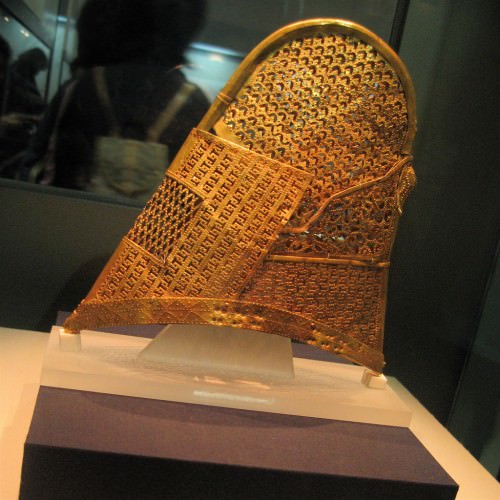
Gold Silla Cap
Two gold caps, one from the Heavenly Horse Tomb and another from the Gold Crown Tomb are similar in design. Both are around 18 cm in height and made from four separate gold sheets which display various intricate open-work patterns. The sheets are joined together by gold rivets and wiring. A third cap, this time in silver and gilt bronze, is less ornate and was excavated from the Great Tomb at Hwangnam.
Some crowns have feather or wing-like decorations, which suggest the importance of birds in Silla culture, a fact corroborated by Chinese records (the San- kuo - chih or 'History of the Three Kingdoms') noting that the cultures prior to the Silla kingdom buried bird's wings with their dead. In shamanism, which was prevalent in early Korea, wings are associated with flight in the spiritual world. For this reason, some scholars suggest that the stag-like pieces on the crown diadem are also stylised bird's feathers. One wing-like decoration from the Heavenly Horse tomb measures 45 cm across and is decorated with over 400 tiny spangles individually attached with gold wire.
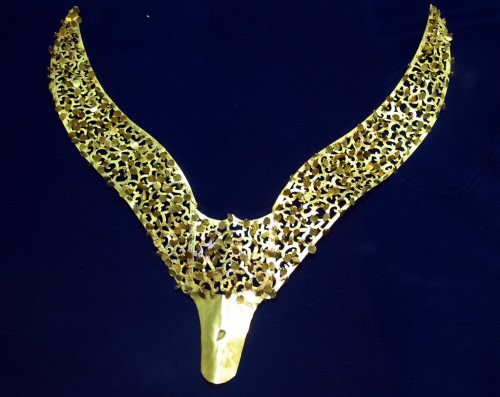
Gold Silla Crown Ornament
Such is the magnificence of the crowns and other pieces buried with the dead that some scholars have pointed out that they could only have been created for that purpose while others point out the wear and tear on some pieces which suggests they were actually used during the lives of the tombs' occupants.
JEWELLERY PIECES
The Silla tombs contained not only crowns but all manner of gold jewellery such as earrings, chain necklaces, girdles, and even shoes and caps, which would have been silk -lined for greater comfort. There are also a staggering 20,000 glass beads recovered from the tombs. Earrings can have a distinctly thick, hollow, tubular upper part from which hang pendants, for example in the form of a cluster of leaves either plain or with pale blue glass additions, glass beads or carved jade pieces.Other earrings have a thinner but solid ring from which hang pendants. It is interesting to note that earrings were worn by both male and female occupants of the tombs. Gold bracelets are generally plainer affairs with simple notching on the outer edges.

Silla Gold Earrings
The girdles, perhaps influenced by the Chinese Han Dynasty, have pendants of various lengths and design. The most outstanding example is from the Gold Crown Tomb, which has 17 miniature pendants. These include a sheathed knife, fish, tassel, a container for acupuncture needles, tweezers, symbolic whetstones, a perfume bottle in glass with a gold-wire cage, scissors, and curved jade pieces. The pendants represent essential objects associated with and worn by government officials as mentioned in the Tang Dynasty history, the Tang - shu. This tradition was probably based on the practice of nomadic tribespeople wearing tool belts. The belt itself is made from 39 gold openwork plaques (originally fixed to a cloth or leather backing) with a buckle and thong to attach it. The floral designs and woven chains of the girdle show a Chinese influence, probably brought via Baekje, the contemporary kingdom in the south-west of Korea.
The crowns and many jewellery pieces feature prominently on the official list of National Treasures of Korea, and many can be seen today in the National Museum of Korea, Seoul and the Gyeongju National Museum. The British Museum in London also has some examples of gold earrings from the Silla tombs.

Silla Gold Girdle
UNANSWERED QUESTIONS
There are still many unanswered questions regarding the five Silla crowns. One of those is who actually wore them. A king would seem an obvious answer, but the crowns all date to the mid-5th to mid-6th century CE, a period in which the Silla had only four kings. There may be many more crowns to be discovered, indeed, this seems likely as another 155 tombs are known in the Gyeongju area and 80% have yet to be excavated. It would seem then that not only kings were buried with crowns.Further, a gold belt in the Great Tomb at Hwangnam has an inscription which reads 'lady's belt' suggesting the occupant was a queen. Then there is the smaller size of objects in the Gold Bell Tomb and the smaller diameter of the crown (16.4 cm compared to around 20 cm for the others) which might indicate the occupant was a young prince. It is also the only crown without jade decoration. Could this be significant? As with so many other mysteries of ancient history, perhaps only time will tell just who was buried with the gold crowns of Silla and who had the right to wear them when alive.
This article was made possible with generous support from the British Korean Society.
LICENSE
Article based on information obtained from these sources:with permission from the Website Ancient History Encyclopedia
Content is available under License Creative Commons: Attribution-NonCommercial-ShareAlike 3.0 Unported. CC-BY-NC-SA License